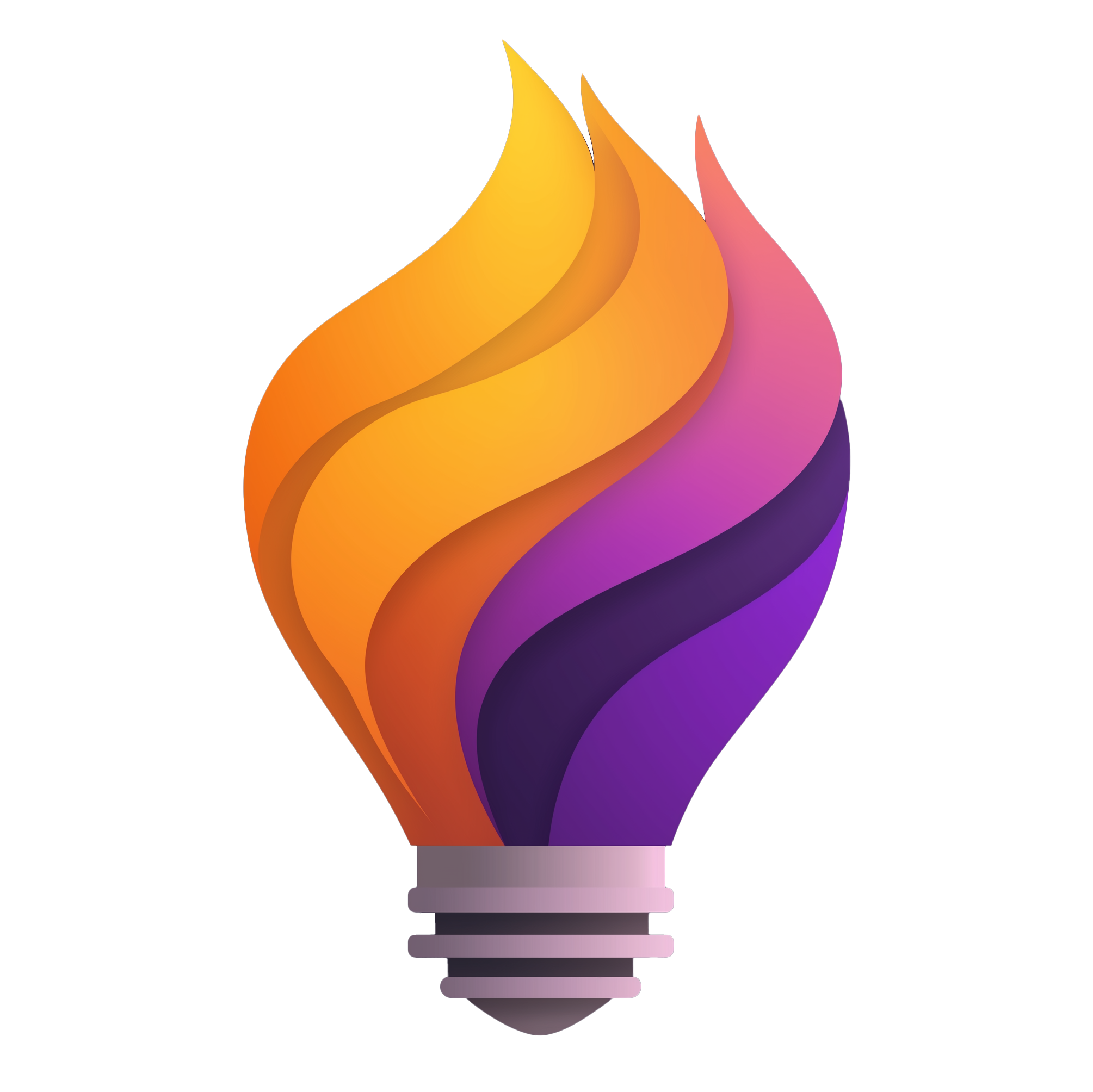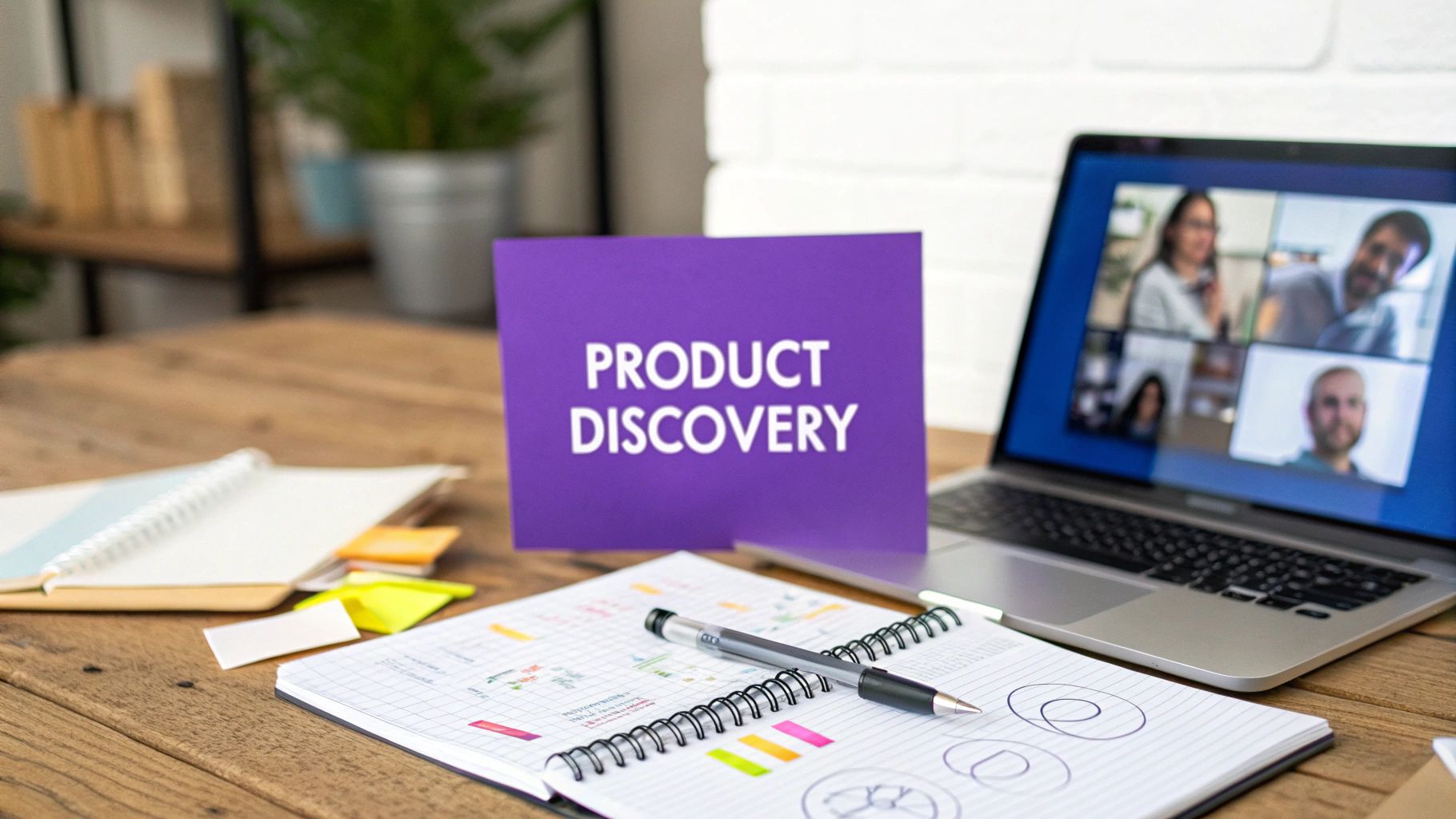Building a successful product isn't about having a single brilliant idea; it's about systematically uncovering genuine user needs and validating solutions. This is the heart of product discovery. Relying on gut feelings or outdated methods is a recipe for building features nobody wants. The key to innovation lies in a structured, continuous approach to understanding your customers' world and de-risking your roadmap.
To truly unlock innovation and prevent costly mistakes, understanding a disciplined approach to the initial stages is crucial. For teams looking to formalize this process, it's helpful to review a detailed breakdown of what this entails. For more insights, consider this comprehensive resource: A Guide to the Software Development Discovery Phase. This structured thinking is essential before diving into specific methods.
This article cuts through the noise to give you a toolkit of actionable product discovery techniques. We'll explore ten powerful methods that modern teams, especially remote and hybrid ones, use to align stakeholders and consistently deliver value. Each technique offers a unique lens for viewing the problem space, ensuring you’re not just building the product right, but building the right product from the start. Let's dive into the list.
1. User Interview
User interviews are one of the most foundational product discovery techniques, involving direct, one-on-one conversations with your target audience. The goal is to uncover deep qualitative insights into their motivations, pain points, and daily workflows. Unlike surveys, these semi-structured discussions allow you to dig into the "why" behind user actions, providing rich context that quantitative data often misses.
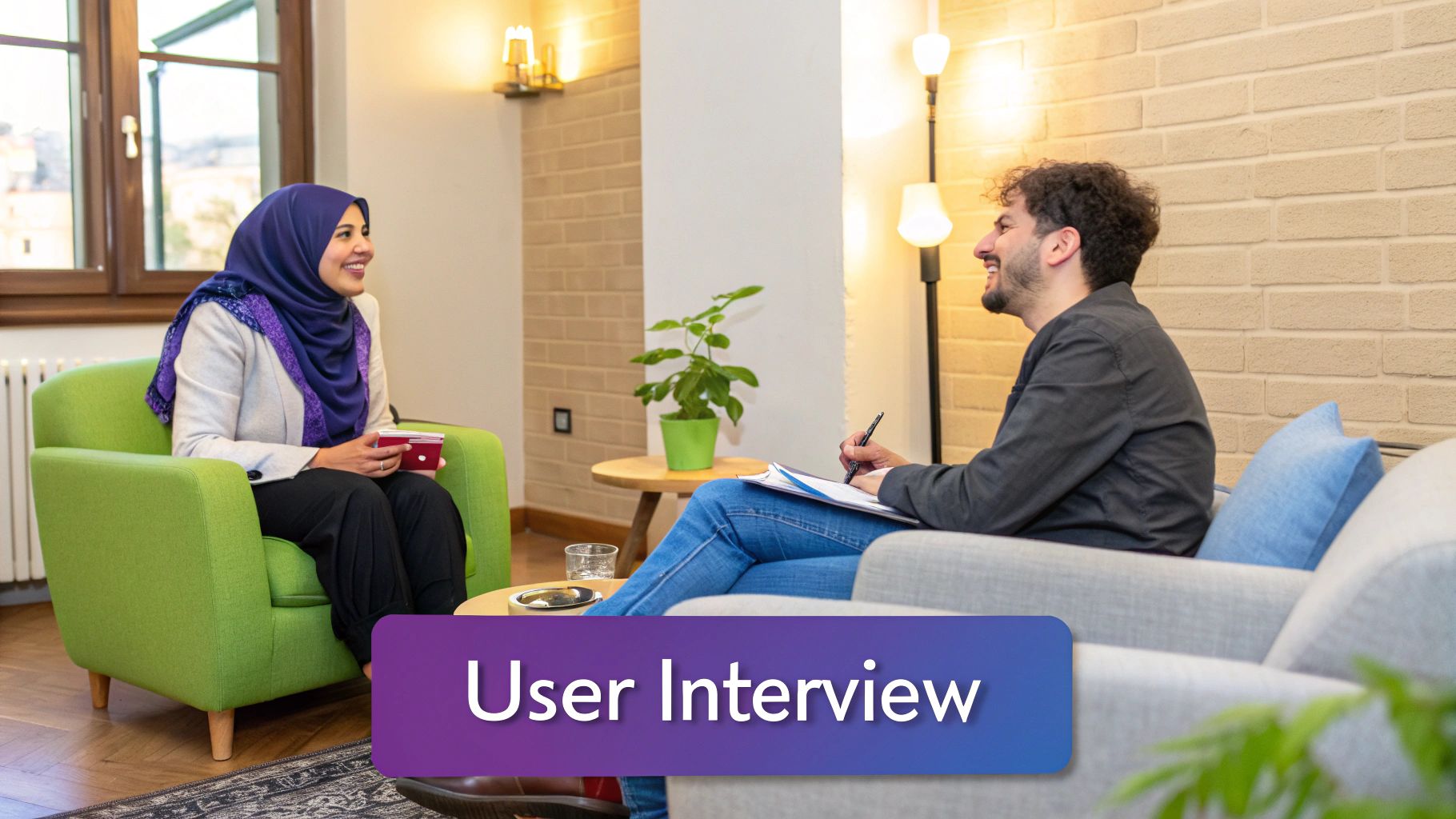
This method is crucial in the early stages of discovery to validate problem spaces before committing resources to a solution. For example, before building its collaboration tool, Slack conducted interviews to understand the specific communication frustrations teams faced. These conversations revealed a need for a centralized, searchable hub for team conversations, directly shaping the product's core features.
How to Implement This Technique
- Define Your Goal: Start with a clear learning objective. Are you trying to understand a specific workflow, a purchasing decision, or a particular frustration?
- Recruit Participants: Find 5-7 people who accurately represent your target user segment.
- Create a Discussion Guide: Outline key open-ended questions, but stay flexible enough to explore unexpected topics that arise during the conversation.
- Conduct and Record: Run 30-60 minute sessions. Ask for permission to record the call for easier analysis later.
Pro Tips for Success
- Focus on Past Behavior: Instead of asking, "Would you use a feature that does X?" ask, "Tell me about the last time you tried to solve Y." This grounds the conversation in real experiences, not speculation.
- Avoid Leading Questions: Don't ask questions that hint at a "correct" answer. Phrase them neutrally to get unbiased responses.
- Use the "Five Whys": When a user mentions a problem, ask "why" multiple times to drill down to the root cause.
- Analyze for Patterns: Look for recurring themes, pain points, and behaviors across multiple interviews. A single opinion is an anecdote; a pattern is a valuable insight.
For remote teams, conducting interviews via video call is highly effective. Mastering this skill is a gateway to better product decisions. For a deeper guide, you can learn more about how to conduct effective user research.
2. Jobs To Be Done (JTBD)
Jobs To Be Done (JTBD) is a powerful framework that shifts your focus from product features to customer motivations. Instead of asking what features users want, it asks what "job" they are trying to accomplish when they "hire" your product. This theory, popularized by Clayton Christensen, suggests customers don't buy products; they hire them to make progress in their lives under specific circumstances.
This perspective is one of the most transformative product discovery techniques because it uncovers the real reasons behind a purchase. For example, McDonald's famous milkshake study revealed morning commuters "hired" milkshakes to solve the job of making a long, boring drive more interesting. This insight had nothing to do with taste and everything to do with the job of alleviating commute boredom.
How to Implement This Technique
- Identify the "Job": Start by interviewing customers who recently switched to (or away from) your product. Focus on understanding the circumstances that triggered their decision.
- Map the Journey: Document the customer's entire progress-making journey, from the first thought of needing a solution to the final purchase and beyond.
- Analyze the Forces: Identify the "forces" at play. What pushed them away from their old solution? What pulled them toward yours? What anxieties or habits created friction?
- Synthesize Job Stories: Frame your findings as "Job Stories" (e.g., "When [situation], I want to [motivation], so I can [expected outcome]").
Pro Tips for Success
- Focus on Switchers: Interviewing people who have recently changed solutions provides the clearest insights into the decision-making process.
- Look for Workarounds: Pay close attention to the "hacks" or non-traditional tools customers use. These often reveal unmet needs and the true job to be done.
- Distinguish Big vs. Small Jobs: A customer might have a large, overarching job (like "manage my team's projects") composed of many smaller jobs (like "quickly see what my team is working on today").
- It's Not a Persona: Unlike personas, which focus on attributes, JTBD focuses on the situation and the desired progress, making it more actionable for product design.
JTBD is a core component of many successful product strategies. To explore it further, you can learn more about how it fits within other product strategy frameworks.
3. Opportunity Solution Trees
An Opportunity Solution Tree (OST) is a visual framework that helps product teams structure continuous discovery by connecting a desired business outcome to potential solutions. Popularized by Teresa Torres, this technique maps how solution experiments address customer opportunities that ladder up to a clear product goal. This keeps teams focused on outcomes over outputs.
The diagram below illustrates the hierarchical structure of an OST, showing how a desired outcome branches into opportunities, which then lead to potential solution experiments.
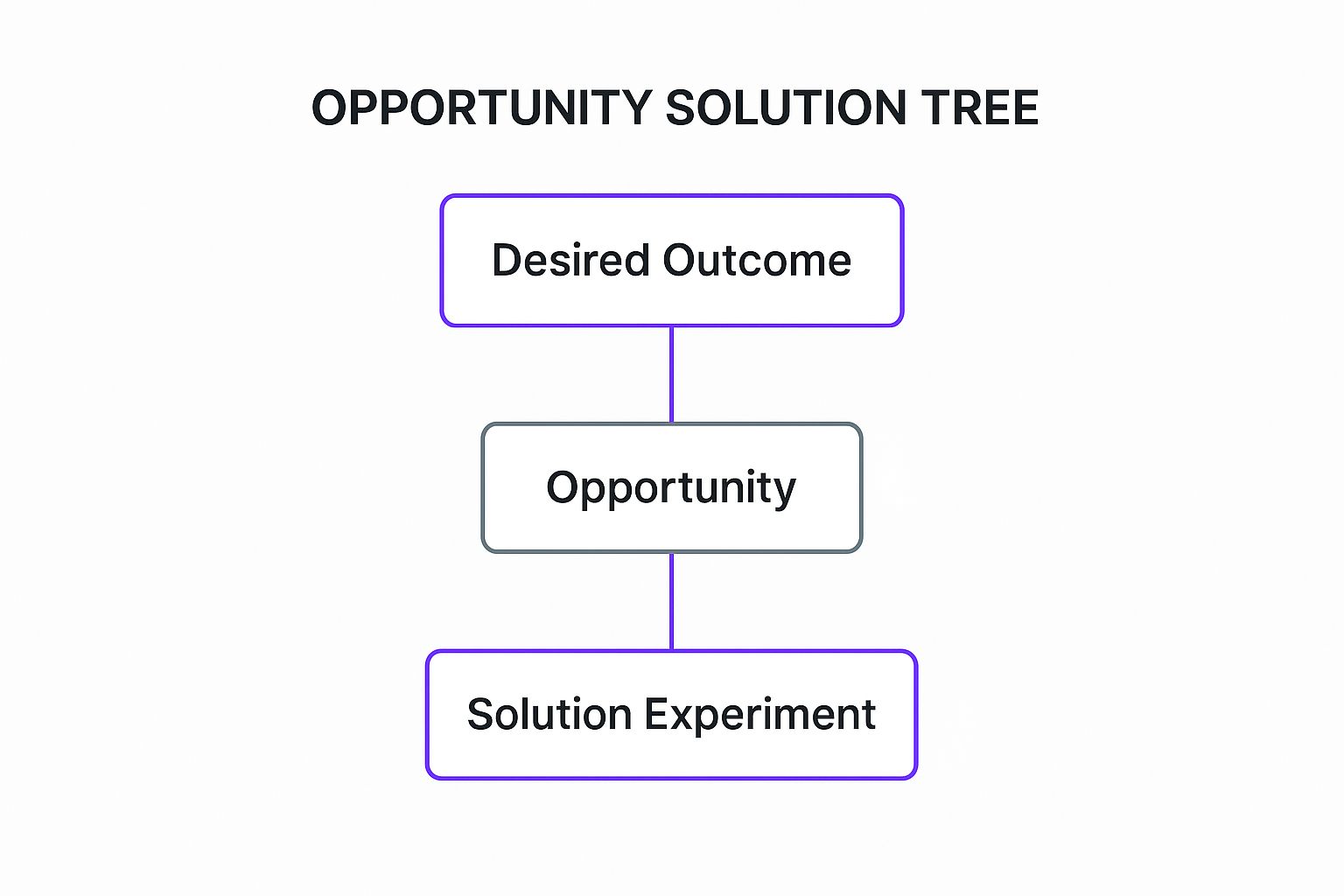
This structure ensures every solution being tested is directly tied to a customer need and the overarching business goal. For instance, CarMax uses OSTs to systematically explore customer pain points, ensuring its product trios remain aligned and focused on solving the right problems.
How to Implement This Technique
- Define Your Outcome: Start with a single, clear, measurable business outcome at the top of your tree (e.g., "Increase user retention by 15% in Q3").
- Generate Opportunities: Based on user research, identify customer pain points, needs, or desires that stand in the way of that outcome.
- Brainstorm Solutions: For your highest-priority opportunities, brainstorm multiple potential solutions or features that could address them.
- Design Experiments: Turn your best solution ideas into small, testable assumptions you can validate with experiments.
Pro Tips for Success
- Discover Opportunities First: Generate opportunities directly from user interviews and research, not internal assumptions.
- Prioritize Ruthlessly: Use dot voting or other collaborative methods with your product trio to decide which opportunities to tackle first.
- Keep Solutions as Assumptions: Treat solutions as hypotheses to be tested, not as a committed backlog. This encourages learning and iteration.
- Update and Share: Review and update your tree weekly with new insights from experiments. Share it regularly with stakeholders for transparency and alignment.
This technique is excellent for remote teams as it provides a shared visual artifact that keeps everyone focused on the same goal. To dive deeper, check out Teresa Torres' book, Continuous Discovery Habits.
4. Prototype Testing
Prototype testing is a powerful product discovery technique where teams create simplified versions of a product to test with users before development. Prototypes can range from low-fidelity paper sketches to high-fidelity interactive mockups. The core goal is to validate assumptions, identify usability flaws, and refine designs early, saving significant time and resources.
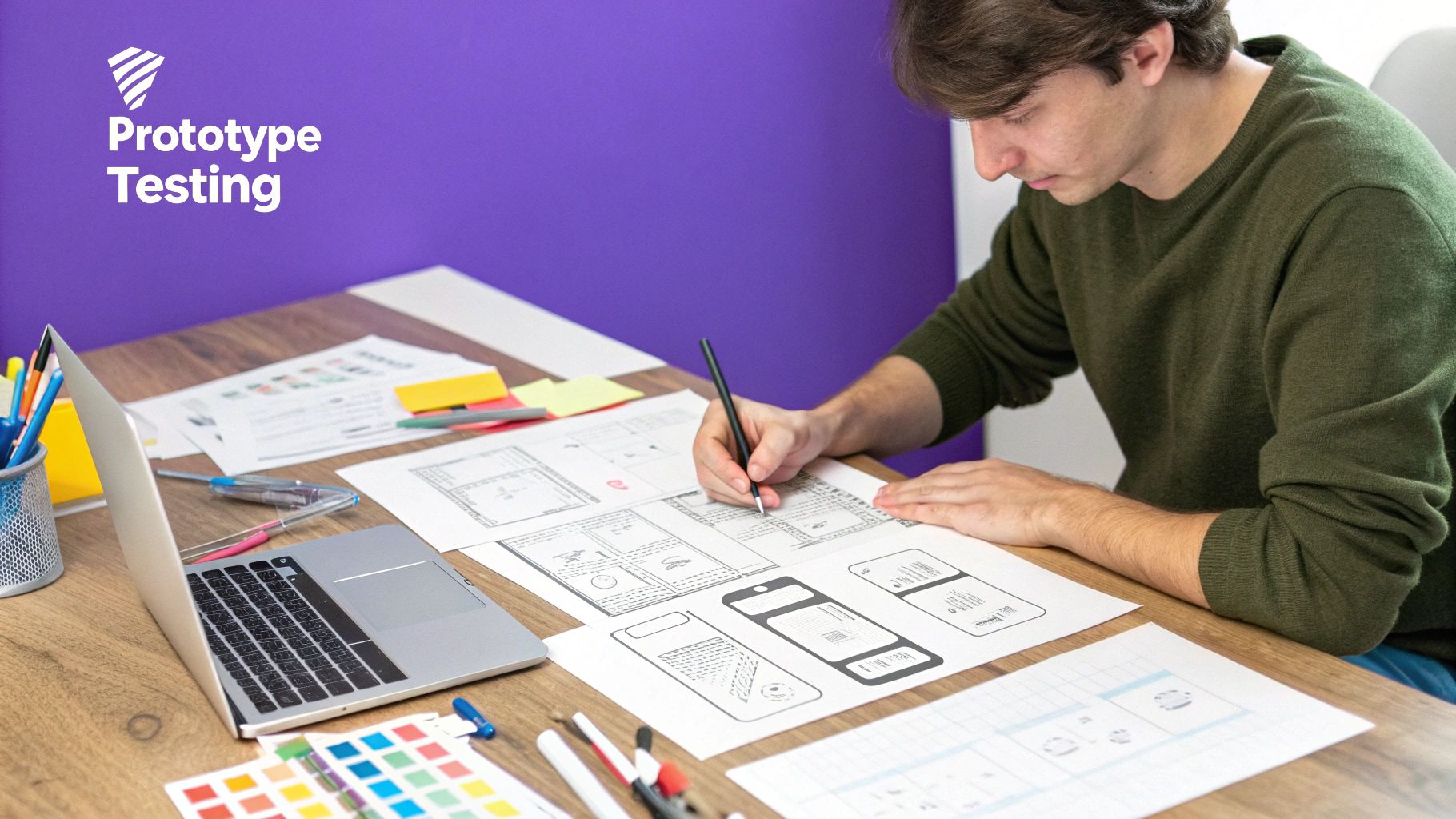
This method allows you to fail cheaply and learn quickly. Dropbox famously validated its entire concept with a simple video prototype that demonstrated the file-syncing magic before a single line of code was written for the actual product. This early feedback confirmed user interest and secured initial investment, proving that a prototype doesn't have to be complex to be effective.
How to Implement This Technique
- Define Your Hypothesis: Clearly state what you want to learn. Are you testing a user flow, the appeal of a new feature, or the clarity of your value proposition?
- Choose Your Fidelity: Match the prototype's detail to your learning goal. Use low-fidelity sketches for early-stage concepts and high-fidelity mockups for usability testing.
- Create a Realistic Task: Give users a specific, realistic goal to achieve with the prototype, such as "Find and share a report with a coworker."
- Observe and Gather Feedback: Watch how users interact with the prototype without guiding them. Encourage them to "think aloud" to capture their thought process.
Pro Tips for Success
- Test Early and Often: Don't wait for a perfect, polished design. The earlier you get feedback, the easier it is to make changes.
- Focus on Behavior, Not Opinions: A user saying "I like it" is less valuable than observing them struggle with a specific button. Pay attention to what they do.
- Test One Variable at a Time: When comparing different design options, change only one key element between versions to isolate what works best.
- Focus on Learning, Not Selling: The goal is to uncover flaws and incorrect assumptions, not to convince the user your idea is great. Embrace critical feedback.
For distributed teams, tools like Figma and InVision make remote, unmoderated prototype testing seamless. To go deeper, you can explore various rapid prototyping methods.
5. A/B Testing and Experimentation
A/B testing is a quantitative method where two or more versions of a product experience are shown to different user segments at the same time. The goal is to determine which variant performs better against a predefined success metric, removing guesswork from product decisions by measuring actual user behavior. This data-driven approach is one of the most powerful product discovery techniques for optimizing existing features.
This method is ideal for validating hypotheses about user behavior at scale. For instance, Booking.com famously runs over 1,000 concurrent experiments to optimize every part of its user journey. This continuous experimentation allows them to make incremental improvements that collectively drive significant business impact, proving that even small changes can influence user decisions when validated with real data.
How to Implement This Technique
- Formulate a Hypothesis: Start with a clear, testable hypothesis. For example, "Changing the 'Add to Cart' button color from blue to orange will increase clicks by 10% because it stands out more."
- Create Variants: Develop the different versions (A and B) you want to test. Ensure they only differ by the one element you are testing.
- Define Metrics and Audience: Choose your primary success metric (e.g., click-through rate, conversion rate) and determine the target user segment and necessary sample size.
- Run the Test and Analyze: Use an experimentation tool to run the test until you reach statistical significance. Analyze the results to determine the winning variant.
Pro Tips for Success
- Test One Variable at a Time: To get clear insights, ensure each test focuses on a single hypothesis and a single change.
- Run Tests Long Enough: Let experiments run for at least one full business cycle (typically a week) to account for daily fluctuations and novelty effects.
- Combine with Qualitative Insights: Use quantitative data to see what happened and qualitative research, like user feedback, to understand why it happened.
- Document Everything: Maintain a log of all experiments, including the hypothesis, results, and learnings, to build institutional knowledge and inform future tests.
For remote teams, modern experimentation platforms like Optimizely or VWO make it easy to deploy and monitor tests without needing physical colocation. For a comprehensive overview, you can learn more about the history and impact of A/B testing.
6. Analytics and Data Analysis
Analytics and data analysis involves examining product usage data to uncover quantitative insights into user behavior. This powerful product discovery technique helps you understand what users are actually doing inside your product, which features they engage with, where they drop off, and what actions correlate with long-term retention. It moves beyond what users say to what they do.
This method is crucial for identifying optimization opportunities and validating hypotheses at scale. For instance, Spotify analyzes listening patterns to inform its powerful recommendation engine and personalized playlists. Similarly, LinkedIn uses cohort analysis to understand what actions new users take that lead to long-term engagement, informing their onboarding and feature prioritization.
How to Implement This Technique
- Define Key Metrics: Identify the metrics that matter most to your business goals (e.g., activation rate, feature adoption, user retention). Avoid vanity metrics.
- Set Up Event Tracking: Implement an analytics tool like Amplitude or Mixpanel to track specific user actions (events) within your product. Create a clear event taxonomy.
- Analyze Funnels and Cohorts: Build funnels to see where users drop off in key workflows. Create user cohorts to compare the behavior of different segments over time.
- Formulate Hypotheses: Use the data to form educated guesses about user problems or opportunities, which you can then validate with other discovery methods.
Pro Tips for Success
- Combine with Qualitative Data: Use analytics to identify what is happening, then use interviews or surveys to understand the why behind the numbers.
- Focus on Actionable Insights: Don't just report on data. Ask, "What decision can we make based on this information?"
- Segment Your Users: Analyze behavior based on different user segments (e.g., new vs. power users, by plan type) to uncover more nuanced insights.
- Set Up Alerts: Create automated alerts for significant changes in your key metrics to quickly spot problems or opportunities.
For remote teams, shared dashboards and regular data reviews are key to keeping everyone aligned. To go deeper, learn more about the principles in the book Lean Analytics.
7. Customer Development and Problem Interviews
Customer Development is a framework, popularized by Steve Blank, that prioritizes learning about customer problems before building solutions. This approach moves product discovery out of the office and into the real world through direct conversations. The goal is to validate that a problem is urgent, pervasive, and that customers are actively trying to solve it.
This method is foundational to the Lean Startup movement and helps teams avoid building something nobody wants. For instance, before writing a single line of code, the Dropbox founders validated their idea with a simple explainer video that demonstrated the problem of file syncing. The massive sign-up rate confirmed the problem was real and widespread, justifying the investment in building the actual product.
How to Implement This Technique
- Formulate Hypotheses: Document your core assumptions about the customer, their problem, and your proposed solution.
- Identify Target Segments: Define the specific group of people you believe are experiencing this problem most acutely.
- Conduct Problem Interviews: Run conversations focused entirely on the customer's world. Do not pitch your idea; instead, explore their current workflows, frustrations, and any workarounds they use.
- Synthesize and Iterate: Analyze interview notes for patterns. Based on your findings, validate, invalidate, or refine your initial hypotheses.
Pro Tips for Success
- Talk to 10-15 People: Aim for this number per customer segment to start seeing reliable patterns in their responses.
- Focus on Past Behavior: Ask, "Tell me about the last time you struggled with [the problem]." This elicits real stories, not hypotheticals.
- Look for Emotion: Strong emotional reactions like frustration or anger are powerful indicators of an urgent, high-value problem.
- Be Ready to Pivot: The primary goal is learning. If the data shows your initial assumption was wrong, be prepared to change direction based on what your customers are telling you.
This technique is essential for early-stage startups and teams entering new markets, as it systematically de-risks new product ideas. A great resource for mastering this is Rob Fitzpatrick's book, The Mom Test.
8. Design Sprints
A Design Sprint is a time-constrained, five-day process for answering critical business questions through rapid prototyping and user testing. Popularized by Jake Knapp at Google Ventures, this product discovery technique compresses months of debate and development into a single, focused week. It provides a structured shortcut to learning without building and launching an entire product.
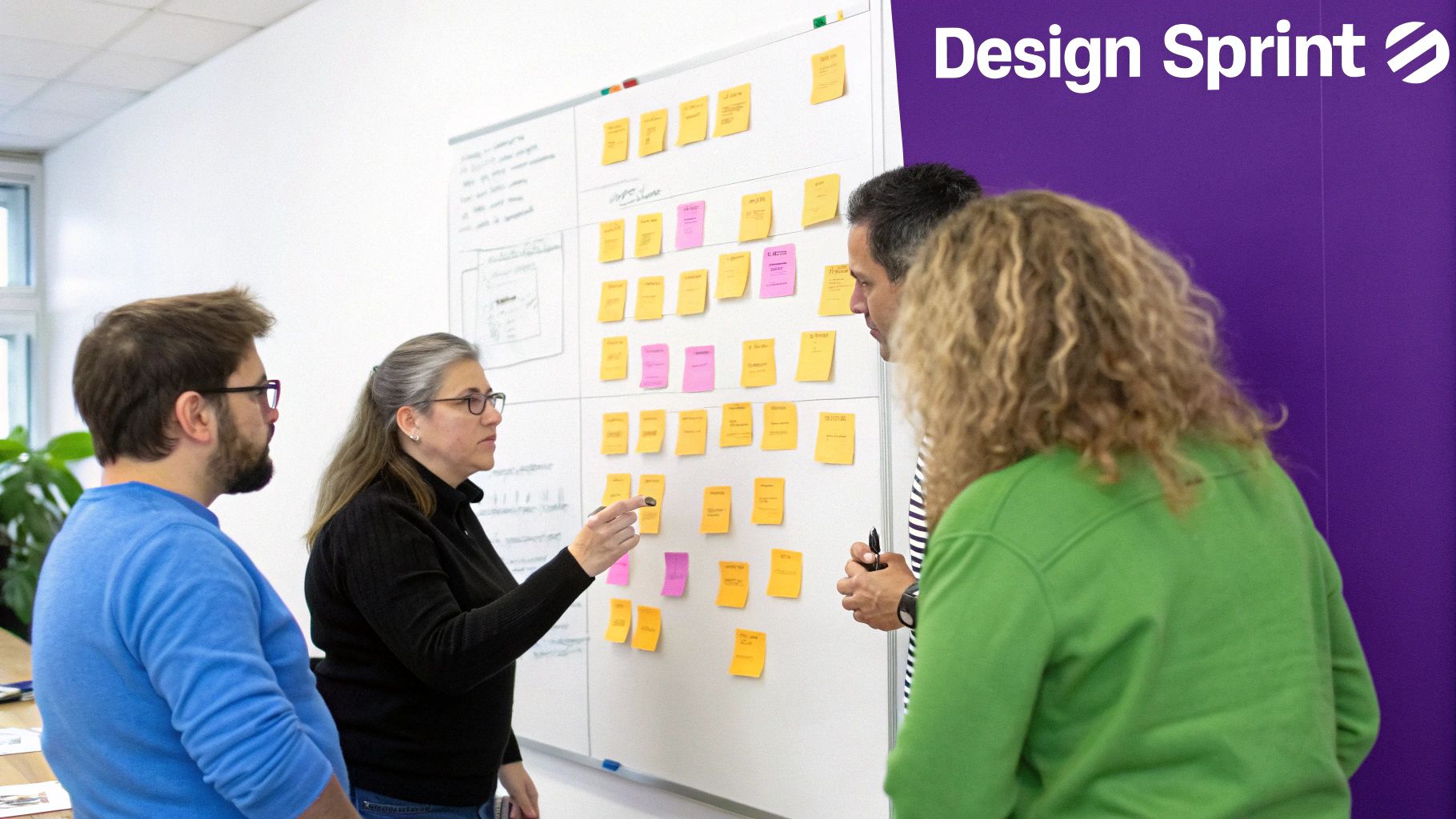
This method is ideal for high-stakes challenges, such as launching a new product, exploring a significant new feature, or pivoting your strategy. For example, Slack has used design sprints to refine its user onboarding flow, allowing them to test and validate changes with real users in just days. The structured process helps teams align quickly and make tangible progress on complex problems.
How to Implement This Technique
- Map (Monday): Align on a long-term goal and map out the challenge. Select a specific target area to focus on for the rest of the week.
- Sketch (Tuesday): Individually sketch potential solutions on paper, focusing on critical thinking rather than artistic skill.
- Decide (Wednesday): Critique all solutions and use a structured decision-making process to choose the best one to prototype.
- Prototype (Thursday): Build a realistic prototype of the chosen solution. The goal is to create a facade of a real product that users can react to.
- Test (Friday): Show your prototype to five real customers in one-on-one interviews to gather direct feedback.
Pro Tips for Success
- Pick the Right Problem: Choose a challenge that is significant but not so broad it can't be tackled in a week.
- Get the Decider: Ensure the key decision-maker is present for the entire sprint to avoid delays and second-guessing.
- Recruit Testers Early: Start recruiting your Friday test participants on Monday to ensure you have them lined up.
- Trust the Process: Especially for your first sprint, follow the day-by-day structure exactly as prescribed. It is designed to create focus and prevent common pitfalls.
For remote or hybrid teams, running a virtual design sprint requires careful planning and strong facilitation skills. To dive deeper, you can learn more about how to effectively facilitate virtual workshops.
9. Feature Usage Analysis and Feature Audits
Feature usage analysis involves systematically examining how users interact with your existing product features. The goal is to understand which features deliver value and which ones create unnecessary complexity. A feature audit takes this a step further, comprehensively reviewing all features to identify which to improve, promote, or remove entirely.
This technique is a powerful product discovery tool because it grounds your roadmap decisions in real user behavior, not just assumptions. For example, by analyzing its Office suite, Microsoft discovered that 80% of users engaged with only 20% of the features, a finding that heavily influenced the redesign of its user interface. Similarly, Intercom famously removed half of its features to sharpen its focus on the core value proposition.
How to Implement This Technique
- Define Key Metrics: Establish clear metrics for each feature, such as reach (percentage of users who have used it), frequency (how often it is used), and depth (how thoroughly users engage with it).
- Gather Usage Data: Use product analytics tools to collect quantitative data on your defined metrics.
- Segment Your Analysis: Break down the data by user segments like plan level, user role, or customer tenure to uncover more nuanced patterns.
- Make Strategic Decisions: Use the insights to decide whether to invest in, modify, deprecate, or heavily market specific features.
Pro Tips for Success
- Combine with Qualitative Data: A feature might have low usage but high satisfaction among a key user segment. Combine quantitative data with user feedback to understand the "why."
- Create a Feature Portfolio Matrix: Plot features on a grid of value vs. adoption to help visualize priorities and identify quick wins or candidates for removal.
- Announce Deprecation Clearly: If you decide to remove a feature, communicate the change well in advance and provide clear migration paths for affected users.
- Measure Against Objectives: Evaluate features based on their contribution to strategic business goals, not just raw usage numbers.
This evidence-based approach helps teams simplify the product and focus resources effectively. To get a deeper understanding of how to make these tough calls, you can learn more about how to prioritize product features.
10. Assumption Mapping and Testing
Assumption mapping is a strategic product discovery technique for identifying and systematically testing the core beliefs that underpin your product idea. Instead of building features based on unproven ideas, teams list all their assumptions about customers, problems, and the business model. These are then prioritized based on their importance and the level of uncertainty. This ensures you test the riskiest assumptions first, minimizing waste.
This method is fundamental to the Lean Startup methodology, helping teams avoid building something nobody wants. For instance, before writing a single line of complex code, Dropbox tested its riskiest assumption-that people would want a file-syncing service-with a simple explainer video. The overwhelming sign-ups from the video validated their core premise before they invested heavily in engineering.
How to Implement This Technique
- Identify Assumptions: Brainstorm and list every assumption you have about your users (desirability), the solution (feasibility), and the business model (viability).
- Map and Prioritize: Plot each assumption on a 2×2 matrix with "Importance" on one axis and "Certainty" on the other. Focus on the high-importance, low-certainty quadrant.
- Design an Experiment: For your top-priority assumption, create the smallest, fastest experiment possible to get evidence.
- Test and Learn: Run the experiment, measure the results against your predefined success criteria, and update your assumption map with what you’ve learned.
Pro Tips for Success
- Involve the Whole Team: Diverse perspectives from engineering, design, and marketing will uncover a wider range of hidden assumptions.
- Prioritize Ruthlessly: Ask the critical question: "If this assumption is proven false, will our entire idea fail?" Test those first.
- Define Success Upfront: Before running a test, agree on what specific metric (e.g., 10% signup rate) will validate or invalidate the assumption.
- Distinguish Facts from Beliefs: Clearly label which items on your map are validated facts and which are still unproven assumptions. This visual clarity keeps the team honest.
Assumption mapping is one of the most powerful product discovery techniques for navigating uncertainty and making evidence-based decisions, especially for remote teams launching new ventures. For a comprehensive guide, check out David J. Bland's book, Testing Business Ideas.
Top 10 Product Discovery Techniques Comparison
| Method | Implementation Complexity 🔄 | Resource Requirements ⚡ | Expected Outcomes 📊 | Ideal Use Cases 💡 | Key Advantages ⭐ |
|---|---|---|---|---|---|
| User Interview | Medium – requires skilled interviewer and scheduling | Moderate – 5-15 participants, recording/transcription tools | Deep qualitative insights on user needs and motivations | Early discovery, understanding problem space | Rich contextual insights, builds empathy, flexible |
| Jobs To Be Done (JTBD) | High – abstract framework needing practice | Moderate – customer interviews, analysis time | Customer-centric understanding of motivations and market opportunities | Defining product strategy, market entry, why customers switch | Reveals hidden competition, stable customer focus |
| Opportunity Solution Trees | Medium-High – setup and ongoing maintenance | Moderate – team alignment and continuous updates | Visual mapping of outcomes to opportunities and experiments | Continuous discovery, maintaining outcome focus | Prevents premature solutions, shared understanding |
| Prototype Testing | Medium – creating prototypes at various fidelity levels | Moderate – prototype tools, recruiting 5-8 test users | Validated design concepts, usability insights | Design validation, usability testing, early iteration | Rapid feedback, reduces costly development errors |
| A/B Testing and Experimentation | High – technical setup and statistical analysis | High – requires significant traffic and experimentation tools | Quantitative, data-driven validation of product changes | Optimization of existing features, data-driven decisions | Objective results, reduces risk, continuous learning |
| Analytics and Data Analysis | Medium-High – requires instrumentation and data governance | High – analytics tools, dashboards, data experts | Quantitative understanding of user behavior and product impact | Monitoring usage patterns, identifying friction | Scalable insights, identifies trends, always-on data |
| Customer Development & Problem Interviews | Medium – structured interviews, avoidance of pitching | Moderate – 10-15 interviews per segment | Validated problem urgency, market need | New product validation, market entry, product-market fit | Reduces risk, validates demand, early adopter insights |
| Design Sprints | High – requires full team availability and facilitation | High – 5-day time box, prototyping resources | Rapid validated prototypes, stakeholder alignment | High-stakes decisions, rapid validation of ideas | Fast, focused, breaks routines, proven methodology |
| Feature Usage Analysis & Audits | Medium – requires data collection and periodic review | Moderate – analytics access, cross-functional involvement | Identification of feature value and simplification needs | Managing feature bloat, prioritization, product simplification | Data-driven decisions, reduces complexity, prioritizes |
| Assumption Mapping & Testing | Medium-High – detailed documentation and experiment design | Moderate – team alignment, experimentation effort | Validated critical assumptions, reduced risk | Early stage validation, strategic pivots | Explicit risk management, focused learning, prevents failure |
From Discovery to Delivery: Putting Your Insights Into Action
The journey through these ten powerful product discovery techniques reveals a crucial truth: building great products is less about a single "aha" moment and more about a continuous, disciplined process of inquiry. We've explored everything from the deep empathy of User Interviews and Jobs To Be Done to the structured clarity of Opportunity Solution Trees and the rapid validation of Prototype Testing. Each method offers a unique lens through which to view your customer’s world.
Mastering these techniques isn't about choosing just one. The most innovative teams build a versatile toolkit, blending qualitative insights with quantitative data to create a holistic view of their market. The real power emerges when these practices are woven into the fabric of your team's culture, creating a perpetual rhythm of learning, building, and measuring. You might start with broad Assumption Mapping to identify your riskiest beliefs and then use targeted A/B Testing to validate them with real user behavior.
Making It Work for Your Team
For remote and hybrid teams, this structured approach is not just beneficial; it's essential for maintaining alignment and momentum. When you can't rely on hallway conversations, clear frameworks like Design Sprints or detailed Feature Audits ensure everyone is working from the same set of facts and toward the same goals. The key is to start small. Don't try to implement all ten techniques at once.
Instead, follow these simple next steps:
- Identify Your Biggest Gap: Where is your team weakest? Are you struggling to understand the core problem? Start with Customer Development. Are you unsure which features to prioritize? Try Feature Usage Analysis.
- Run a Small Pilot: Select one or two techniques and apply them to a single, focused initiative. This builds confidence and demonstrates value without overwhelming your team.
- Document and Share: Make your findings visible. Use shared documents, virtual whiteboards, and dedicated communication channels to ensure insights from discovery efforts don't get lost.
This continuous discovery mindset is the bridge between a promising idea and a successful product. For startups looking to effectively move from concept to launch, a practical guide to product development for startups offers crucial insights into validating ideas and building lean MVPs. The goal is to make evidence-based decision-making the default, not the exception. The journey to building products that customers truly love begins and ends with a deep, empathetic understanding of the people you aim to serve.
Ready to supercharge your discovery process and turn insights into innovation? Bulby provides guided, research-backed brainstorming exercises and ideation tools designed to help your team overcome bias and generate creative solutions. Transform your raw discovery data into actionable ideas with Bulby.
